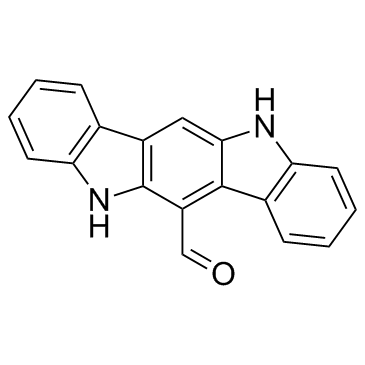| Cas No.: | 172922-91-7 |
| Chemical Name: | 5,11-dihydro-indolo[3,2-b]carbazole-6-carboxaldehyde |
| SMILES: | C1C=CC=C2N=C3C(C=O)=C4C(=NC5C4=CC=CC=5)C=C3C=12 |
| Formula: | C19H12N2O |
| M.Wt: | 284.31 |
| Purity: | >98% |
| Sotrage: | 2 years -20°C Powder, 2 weeks 4°C in DMSO, 6 months -80°C in DMSO |
| Publication: | [1]. Mohammadi-Bardbori A, et al. The highly bioactive molecule and signal substance 6-formylindolo[3,2-b]carbazole (FICZ) plays bi-functional roles in cell growth and apoptosis in vitro. Arch Toxicol. 2017 Mar 13 [2]. Farmahin R, et al. Time-dependent transcriptomic and biochemical responses of 6-formylindolo[3,2-b]carbazole (FICZ) and 2,3,7,8-tetrachlorodibenzo-p-dioxin (TCDD) are explained by AHR activation time. Biochem Pharmacol. 2016 Sep 1;115:134-43 [3]. Smith BW, et al. Genome Editing of the CYP1A1 Locus in iPSCs as a Platform to Map AHR Expression throughout Human Development. Stem Cells Int. 2016;2016:2574152. [4]. Wincent E, et al. Biological effects of 6-formylindolo[3,2-b]carbazole (FICZ) in vivo are enhanced by loss of CYP1A function in an Ahr2-dependent manner. Biochem Pharmacol. 2016 Jun 15;110-111:117-29. |
| Description: | FICZ is a high affinity aryl hydrocarbon receptor (AhR) agonist with Kd of 70 pM; induces transient expression of CYP1A1 in vitro, and potentiates NK cell IFN-γ production and cytolytic activity; enhances NK cell control of tumors in an NK cell- and AhR-dependent manner in vivo; an endogenous AhR ligand. |
| Target: | aryl hydrocarbon receptor (AhR) agonist with a Kd of 70 pM. |
| In Vitro: | FICZ (0.01 nM-1 µM) alone or in combination with 50 nM MNF induces sustained CYP1A1 activity and leads to oxidative stress and activation of apoptosis via a mitochondrial-dependent pathway. In HepG2 cells, FICZ stimulates cell growth at low concentrations but inhibits cell growth at high concentrations[1]. FICZ (10,000-30,000 nM) significantly decreases CEH viability with an estimated LC50 (95% confidence intervals) of 14,000 nM. FICZ shows concentration-dependent effects on EROD activity in CEH cultures, with the mean EC50 values at 3, 8, and 24 h of 0.016 nM, 0.80 nM, and 11 nM, respectively[2]. FICZ treatment increases transcript expression of CYP1A1 in a dose-dependent manner in both the parental iPSC line and the CYP1A1 targeted clone[3]. CYP1 inhibition in the presence of FICZ results in enhanced AHR activation, suggesting that FICZ accumulates in the cell when its metabolism is blocked. CYP1 enzymes plays a role in regulating biological effects of FICZ[4]. |
| Cell Assay: | The cell viability of CEH treated with FICZ or TCDD is studied with the untreated cells (used as a live cell control) and sodium hypochlorite (5%)-treated cells (used as a dead cell control). This assay is based upon the bioluminescent measurement of adenosine triphosphate (ATP) that is present in all metabolically active cells. Luciferase is utilized in this method to catalyze the formation of light from ATP and luciferin. CEH are lysed 24 h after dosing and the luminescence emitted from the ATP-dependent oxidation of luciferin is measured with a LuminoSkan Ascent luminometer. |
| References: | [1]. Mohammadi-Bardbori A, et al. The highly bioactive molecule and signal substance 6-formylindolo[3,2-b]carbazole (FICZ) plays bi-functional roles in cell growth and apoptosis in vitro. Arch Toxicol. 2017 Mar 13 [2]. Farmahin R, et al. Time-dependent transcriptomic and biochemical responses of 6-formylindolo[3,2-b]carbazole (FICZ) and 2,3,7,8-tetrachlorodibenzo-p-dioxin (TCDD) are explained by AHR activation time. Biochem Pharmacol. 2016 Sep 1;115:134-43 [3]. Smith BW, et al. Genome Editing of the CYP1A1 Locus in iPSCs as a Platform to Map AHR Expression throughout Human Development. Stem Cells Int. 2016;2016:2574152. [4]. Wincent E, et al. Biological effects of 6-formylindolo[3,2-b]carbazole (FICZ) in vivo are enhanced by loss of CYP1A function in an Ahr2-dependent manner. Biochem Pharmacol. 2016 Jun 15;110-111:117-29. |

 To enhance service speed and avoid tariff delays, we've opened a US warehouse. All US orders ship directly from our US facility.
To enhance service speed and avoid tariff delays, we've opened a US warehouse. All US orders ship directly from our US facility.




















